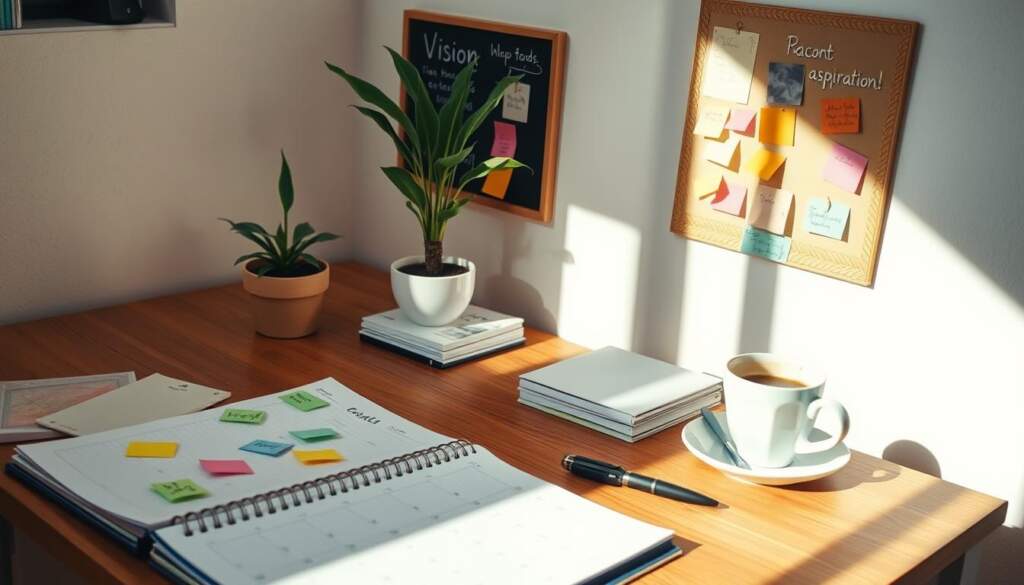Striking a harmonious balance between one’s professional responsibilities and personal life is the cornerstone of managing work-life balance, ensuring not only individual well-being but also fostering personal and career fulfillment. In an era where technology blurs the lines between work hours and personal time, achieving this equilibrium has become increasingly challenging. Yet, it remains essential both for personal satisfaction and as a strategic factor for productivity enhancement within organizations.
Companies that prioritize work-life balance witness a substantial drop in employee turnover—up to 25 percent—highlighting the correlation between flexibility and staff retention1. This approach, coupled with the endorsement of platforms like Smartsheet, trusted by over 90% of Fortune 100 companies to streamline task management, lays a foundation for happier, healthier workplaces12. Furthermore, it transcends to employees’ personal lives, significantly reducing the risk of burnout and bolstering mental and physical health1.
Key Takeaways
- Managing work-life balance leads to less staff turnover and greater company loyalty1.
- The utilization of Smartsheet enhances efficiency in work management1.
- Personal and career fulfillment are closely linked to a healthy work-life dynamic1.
- Productivity enhancement greatly benefits from a well-balanced personal and professional life1.
- An improved work-life balance paves the way for both physical and mental well-being1.
Understanding the Importance of Work-Life Balance
The concept of work-life balance has shifted from being a mere buzzword to a fundamental strategy for enhancing personal wellness and optimizing job satisfaction. In today’s fast-paced work environment, reducing workplace stress is not just about improving individual health but also about bolstering organizational success. A study by Aviva highlights that a significant 41% of workers were drawn to their current positions due to the offered work-life balance, surpassing the allure of salary, which stood at 36% before the pandemic in 20193.
The risks associated with neglecting this balance are stark. Research from UCL demonstrated that white-collar workers logging three or more extra hours than required had a 60% heightened risk of heart-related complications4. This points to the dire need for mitigating burnout and ensuring employee wellness is prioritized.
Furthermore, corporations that cultivate highly engaged workforces experience significantly improved performance metrics. According to Tower Perrin’s global survey, companies with engaged employees saw a 52% increase in performance improvement in operating income, emphasizing how pivotal increasing employee retention is for organizational growth3.
| Focus Area | Benefits |
|---|---|
| Enhanced Work-Life Balance | Decreases risk of burnout and chronic diseases, increases job satisfaction |
| Engaged Employees | Improved operating income, reduced turnover rates |
Additionally, the American Sociological Association has indicated that taking more vacations can notably reduce psychological distress, thereby bolstering mental health and productivity3. On the economic front, the costs linked with high employee turnover can be staggering. Oxford Economic’s analysis suggests that replacing an employee could incur costs up to £30,000 and take as long as 28 weeks to reach full productivity3.
To address these challenges, promoting flexible schedules, as noted by findings where employees show higher productivity and loyalty4, alongside encouraging regular physical activity which has been proven to alleviate stress, depression, and anxiety4, could prove vital. Therefore, fostering a work culture that prioritizes work-life balance not only enhances personal wellness but also paves the way for sustained organizational achievement and resilience.
Identifying the Symptoms of a Poor Balance
The impact of increased workload and inflexible work schedules is visible in various forms across different sectors. When employees are pushed towards longer working hours without sufficient breaks or flexibility, identifying work stressors becomes crucial in maintaining not only workplace harmony but also overall mental health.
The adverse effects of inflexible work schedules are compounded when these are paired with demanding job responsibilities. As studies have shown, nearly 75% of professionals feel overwhelmed due to a lack of balance between their personal and professional lives5. This often leads to employee burnout symptoms, which manifest as physical exhaustion, lack of interest in work, and overwhelming stress.
Recognizing the Role of Increased Work Responsibilities
The increasing demands of modern work environments often lead employees to work longer and more strenuous hours. In Australia, for instance, 13% of people work more than 50 hours each week, which is considered very long hours by international standards6. This overload is not just about the number of hours worked but also the intensity and expectations within those hours. The toll on mental and physical health is significant, with long-term effects that can detract from an employee’s productivity and overall well-being.
Effects of Longer Working Hours and Lack of Flexibility
Inflexible work schedules often leave little room for personal time, which is essential for mental recharge and maintaining a healthy work-life balance. Research highlights that people without flexible working arrangements are 35% more likely to feel disconnected and dissatisfied in their roles5. Such conditions foster an environment where stress and anxiety thrive, increasing the risk by 40% of developing mental health issues directly linked to occupational stress5.
Moreover, burnout remains a crucial factor as a symptom of ongoing and unresolved work stress. This condition not only impairs an individual’s ability to function effectively in the workplace but also extends its impact into their personal lives, causing disruptions in social and family engagements.
| Factor | Impact on Work-Life Balance | % Affected |
|---|---|---|
| Increased Workload | Higher Stress Levels | 75%5 |
| Long Working Hours | Increased Risk of Burnout | 60%5 |
| Lack of Flexibility | Poor Mental Health | 40%5 |
Identifying these work stressors early and addressing them through strategic interventions can mitigate the negative impact they have on employees. Implementing policies that promote flexibility, adequate rest periods, and a supportive workplace culture are essential steps in protecting employees from the severe consequences of poor work-life balance.
How to Achieve a Better Work-Life Balance
Achieving a work-life balance isn’t just beneficial; it’s necessary for maintaining mental health and improving physical well-being. By integrating methodologies such as effective daily goal setting, leveraging productivity tools, and adopting mindfulness techniques, individuals can sustain both productivity and personal satisfaction.
Setting Attainable Daily Goals
Effective daily goal setting allows individuals to see progress in their work, providing a sense of achievement and order. Goals such as establishing a proper and restful sleep routine are essential in maintaining good health, as sufficient sleep is linked to a reduced risk of health issues such as heart disease and diabetes7. Additionally, setting boundaries between work and personal life is recognized for reducing stress and improving overall life balance7.
Embracing Technological Tools to Enhance Efficiency
Leveraging productivity tools such as the Pomodoro technique or digital apps not only helps minimize distractions but also boosts efficiency, making it easier to manage time effectively. A study in 2014 highlighted that productivity decreases significantly after exceeding a certain number of working hours, leading to an increase in errors and potential injuries8. Hence, using these tools can help maintain high productivity levels without the added strain.
Being Mindful About Taking Breaks and Disconnecting
Mindfulness techniques are key components in recognizing the need for essential rest periods. Implementing regular checks on one’s mental state encourages taking timely breaks, essential for mental health and productive output. Practices like meditating, pursuing hobbies, and unplugging from digital devices can greatly enhance mental well-being7.


| Strategy | Benefits | Implementation Tip |
|---|---|---|
| Daily Goal Setting | Improves focus and achievement | Use SMART criteria to define daily targets |
| Productivity Tools | Increase efficiency, reduce fatigue | Integrate tools like Asana or Trello |
| Mindfulness and Breaks | Better mental health, enhanced relaxation | Schedule regular breaks; try apps like Headspace |
By adopting these targeted strategies, individuals can not only improve their professional life but also enhance their personal life, creating a harmonious work-life balance that fosters both health and happiness8.
Time Management Techniques for Work-Life Integration
To excel in both your professional and personal life, establishing effective time management practices is vital. Prioritizing tasks not only streamlines your day but aligns with your peak productivity periods, enhancing your productivity strategies. For instance, millennials emphasize the importance of balancing work and personal life9, valuing this equal to compensation when choosing career paths9.
Incorporating scheduled times for checking messages and attending meetings can drastically reduce the overwhelm, facilitating a smoother integration of work and personal activities. Studies show that the implementation of methods like the POSEC Method, which prioritizes and organizes tasks, significantly aids in maintaining organized schedule planning1.
Experts like Mark Forster recommend adopting systems such as closed lists to avoid the pitfall of endless to-do lists, ensuring essential tasks are completed9, thus promoting better time management. Additionally, tracking daily activities can reveal surprising insights into where and how time is being spent, which is crucial for improving productivity9.
| Activity | Time Allocation | % of Total Week |
|---|---|---|
| Exercise | 10% | 7 hours |
| Meditation/Journaling | Early Morning (30 min daily) | 3.5 hours |
| Social Media | 20 min daily | 2.3 hours |
Moreover, waking up 30 minutes earlier has been a game-changer for many, creating time for meditation or a quick walk—such simple shifts aid significantly in balancing work and personal life10. Similarly, understanding the cumulative impact of seemingly minor activities, like spending 20 minutes on social media daily, illuminates how to reclaim time for more fulfilling pursuits10.


Finally, embracing delegation is not just a leadership skill but a pivotal productivity strategy. James Baker, a time management expert, highlights how delegating can prevent burnout and foster an environment where work and personal life can flourish together9. In conclusion, well-crafted time management and productivity tactics play an essential role in achieving an enviable work-life balance.
Adopting Healthy Habits at Home and Work
Integrating effective strategies for both home and work environments is crucial to sustaining a balanced lifestyle. By focusing on sharing home responsibilities and setting boundaries, individuals can revolutionize their daily routines, enhancing both personal satisfaction and professional productivity.
Dividing Responsibilities and Avoiding Overcommitment
Efficiently sharing home responsibilities not only promotes harmony but also enhances individual accountability, making it easier to manage time and reduce stress. Flexibility in task allocation, as seen in various organizations, can lead to greater employee satisfaction and retention rates11.
Setting boundaries is equally important and can be achieved through practices such as defining clear work hours and sticking to them, as well as learning to say no, which significantly enhances work efficiency12. These actions ensure that personal time remains protected and work stress does not spill over into home life.
Incorporating a ‘No Work at Home’ policy can further cement these boundaries, contributing positively to work-life balance as experienced by employees who have embraced such guidelines11.
The Power of Unplugging and Physical Wellness
Digital detox, or unplugging from technology after work hours, is essential in safeguarding one’s mental health and ensuring relaxation time is spent effectively, without interference from work-related stressors. Managers leading by example in this aspect help set a cultural norm that encourages a healthy balance12.
Focusing on the benefits of regular exercise further aids in maintaining physical wellness which is instrumental in coping with stress and improving overall productivity. Companies that encourage these practices not only enjoy better work culture but also observe a boost in employee engagement11. Regular assessment and encouragement for personal care foster environments where self-care routines are the norm, not the exception, leading to more satisfied and productive workforces11.
Embracing a comprehensive approach to work and home life balance is not just beneficial; it’s necessary for a sustainable and fulfilling life.
| Strategy | Benefits |
|---|---|
| Sharing Home Responsibilities | Reduces individual stress, enhances family dynamics |
| Setting Work Boundaries | Improves focus, prevents burnout |
| Digital Detox | Protects personal time, improves mental health |
| Regular Exercise | Increases energy levels, reduces stress |
Support Systems and Utilizing Available Resources
Building robust support systems is crucial for achieving a balanced lifestyle, particularly as work-life challenges persist across various industries, including HR Management and Employee Relations13. Employee Assistance Programs (EAPs) and other stress management resources play a significant role in providing the necessary support to navigate these challenges effectively. Professionals, especially those aged 50 and older, often face burnout, which can significantly impact their productivity and mental health14.
Leveraging support systems, whether through professional help and coaching or personal networks, helps individuals set and maintain boundaries, a fundamental step for communicating expectations clearly within the workplace13. This is especially pertinent as workplace culture deeply influences an individual’s ability to maintain work-life balance, with a supportive environment being key to fostering this balance13.
For those feeling overwhelmed, engaging with stress management resources can provide valuable guidance on coping mechanisms and strategies to enhance life skills beyond work. This not only helps in mitigating stress but also enriches an individual’s personal life13. Furthermore, strategies that promote work-life balance contribute significantly to a healthier economy by preventing burnout and improving engagement and productivity at work14.
Maintaining these supports involves regular evaluation and adjustment to adapt to changing circumstances, emphasizing the importance of gratitude and reciprocity within these systems to sustain a healthy balance13. For older professionals, integrating physical activity, understanding nutritional needs, and managing health proactively are crucial steps in sustaining well-being in later stages of their career or retirement14.
| Element | Benefit | Key Action |
|---|---|---|
| Employee Assistance Programs | Guidance on personal and professional issues | Enroll and actively participate |
| Professional Help and Coaching | Personalized support and strategy development | Seek consultations regularly |
| Family and Friends | Emotional support and practical help | Engage and communicate needs effectively |
| Physical and Mental Health Activities | Stress reduction and improved well-being | Incorporate regular exercise and mindfulness practices |
Ultimately, the foundation of a sustainable work-life balance lies in actively engaging with and leveraging support systems, ranging from professional avenues like Employee Assistance Programs to personal connections and health-oriented activities. These resources not only alleviate immediate stress but also build resilience against future challenges, ensuring well-rounded personal and professional growth1314.
Conclusion
In our final thoughts on this essential topic, it becomes evident that neglecting personal time is not only detrimental to our mental and physical health, potentially leading to chronic stress, anxiety, and decreased productivity15; it also impacts the bottom line of businesses globally16. Embracing strategies for work-life balance is not simply a personal goal, it’s a professional necessity. Research underscores that individuals who integrate self-care into their routine by prioritizing personal time significantly enhance their work performance, creativity, and motivation – culminating in a 30% increase in efficiency17.
Creating a supportive work environment is a collective effort that starts with fostering a culture where achieving personal harmony is respected and encouraged. By setting boundaries, employees report a considerable surge in job satisfaction17, which in turn cultivates a more dynamic and devoted workforce. It is also crucial to note the role of employers in offering schedules that allow for personal care activities, as a staggering 46% of the workforce takes less time off than they’re entitled to for fear of falling behind or overburdening colleagues16.
Through conscious effort and dedicated strategies, such as effectively managing workload, embracing flexibility, and utilizing benefits like HRAs, both individuals and organizations can reap the rewards of a balanced life1716. Remember, the pursuit of work-life balance is a continuous journey that requires adaptability and a willingness to reassess priorities. As we strive for this equilibrium, we unlock the path to well-being and prosperity in all facets of life.
FAQ
What are effective strategies for managing work-life balance?
Why is work-life balance important to overall well-being?
What are signs of a deteriorating work-life balance?
How can I improve efficiency and reduce stress at work?
What time management techniques support work-life integration?
How can I adopt healthier habits to aid work-life balance?
How can support systems and resources improve work-life balance?
Source Links
- How to Improve Work-Life Balance: 17 Tips | Smartsheet – https://www.smartsheet.com/content/how-to-improve-work-life-balance
- How to Improve Your Work-Life Balance – businessnewsdaily.com – https://www.businessnewsdaily.com/5244-improve-work-life-balance-today.html
- The Importance of Work-Life Balance | The Happiness Index – https://thehappinessindex.com/blog/importance-work-life-balance
- Work Life Balance – https://www.mhanational.org/work-life-balance
- Council Post: 10 Clear Signs You May Need Better Work-Life Balance (And How To Get It) – https://www.forbes.com/councils/theyec/2022/07/12/10-clear-signs-you-may-need-better-work-life-balance-and-how-to-get-it/
- Work-life balance – https://www.healthdirect.gov.au/work-life-balance
- 15 Habits To Achieve A Better Work-Life Balance In Today’s Fast-Paced World – https://www.forbes.com/sites/bernardmarr/2023/05/22/15-habits-to-achieve-a-better-work-life-balance-in-todays-fast-paced-world/
- Work-Life Balance: What It Is and 5 Ways to Improve Yours – https://www.coursera.org/articles/work-life-balance
- Work-Life Balance: Time Management Skills That Work – https://www.aerotek.com/insights/work-life-balance-time-management-skills-that-work
- Time Management Techniques For Work-Life Integration | Berdéo Group – https://www.berdeogroup.com/time-management-techniques-for-work-life-integration/
- 25 Best Ways To Celebrate Work-Life Balance and Its Benefits – https://www.vantagecircle.com/en/blog/work-life-balance/
- Habits for a better work-life balance – https://www.amway.com/en_US/discover/entrepreneurship/work-life-balance-tips
- How can you build a support system for work-life balance? – https://www.linkedin.com/advice/0/how-can-you-build-support-system-work-life-balance-xcbje
- Achieving a Healthy Work-Life Balance: Tips and Strategies – https://promisecare.com/achieving-a-healthy-work-life-balance-tips-and-strategies/
- Work Life Balance: A Guide for Small Business Owners – https://www.michellepontvert.com/blog/work-life-balance-tips
- How to Balance Work and Life: Practical Strategies For Employers – https://www.peoplekeep.com/blog/how-to-maintain-work-life-balance
- Mastering Work-Life Balance | Neal Communities Careers – https://nealcareers.com/2024/04/11/mastering-work-life-balance-strategies-for-a-fulfilling-life/





